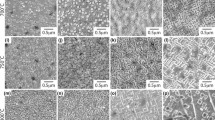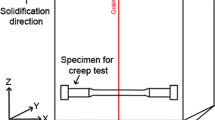Abstract
In a critical temperature range, usually centered about 1400°F., most nickel-base superalloys exhibit a minimum in ductility. In this investigation, metallographic, X-ray, damping, and scanning electron micrography studies have been made on Hastelloy alloy x, a typical solid solution strengthened superalloy. All studies indicate that extensive carbide precipitation, which depletes the lattice of solid solution strengthening elements, occurs in this alloy during plastic deformation at elevated temperatures. On the low temperature side of the minimum, the matrix is strong enough to compel grain boundaries to shear in response to the applied stress, causing severe localized plastic flow and intergranular fracture, thus decreasing the apparent total ductility of the material. Above the minimum ductility temperature, grain boundary shear is still occurring, but the matrix is so depleted in strengthening elements by precipitation that extensive intergranular flow occurs, causing an increase in ductility once again.
Similar content being viewed by others
References
High Temperature, High Strength Nickel Base Alloys, 2nd ed., pg. 37, International Nickel Company, Inc., New York, 1968.
C. G. Bieber and R. F. Decker:Trans. TMS-AIME, 1961, vol. 221, pp. 629–36.
W. F. Savage and M. B. Krantz:Weld. J., 1966, vol. 45,Res. Suppl., pp. 13-S to 24-S.
W. F. Savage and B. M. Krantz:Weld. J., 1971, vol. 50,Res. Suppl., pp. 292-S to 303-S.
D. S. Duvall and W. A. Owczarski:Weld. J., 1969, vol. 48,Res. Suppl., pp. 10-S to 22-S.
F. N. Rhines and P. J. Wray:Trans. ASM, 1961, vol. 54, pp. 117–28.
E. Shapiro and G. E. Dieter:Met. Trans., 1971, vol. 2, pp. 1385–91.
E. Shapiro and G. E. Dieter:Met. Trans., 1970, vol. 1, pp. 1711–19.
H. L. Dunegan:Mater. Eval., June 1964, pp. 266–72.
G. P. Sabol and R. Stickler:Phys. Status Solidi, 1969, vol. 35, pp. 11–52.
C. T. Sims:J. Metals, 1966, vol. 18, pp. 1119–30.
B. D. Cullity:Trans. TMS-AIME, 1963, vol. 227, pp. 356–58.
E. L. Waggoner: Report No. 816-41101-1, Haynes Stellite Co., Kokomo, Ind., June 1961.
H. E. Collins and R. J. Quigg:Trans. ASM, 1968, vol. 61, pp. 139–48.
P. S. Kotval:Trans. TMS-AIME, 1968, vol. 242, pp. 1651–56.
Author information
Authors and Affiliations
Rights and permissions
About this article
Cite this article
Arkoosh, M.A., Fiore, N.F. Elevated temperature ductility minimum in Hastelloy alloy X. Metall Trans 3, 2235–2240 (1972). https://doi.org/10.1007/BF02643237
Received:
Issue Date:
DOI: https://doi.org/10.1007/BF02643237




